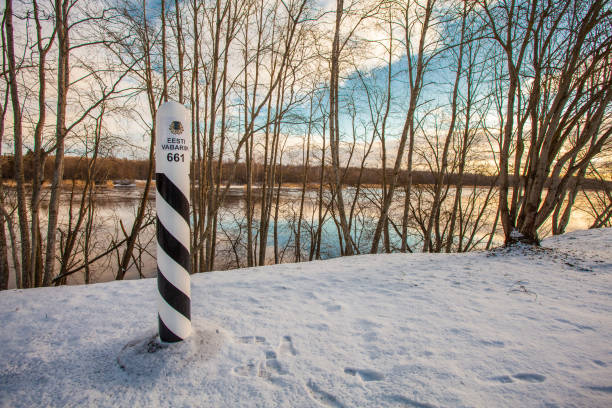Frontex Launches Estonia Base for EU Border Defense
Jul 18, 2025
Category: Border and Security Estonia News

As tensions rise and migration patterns change, the European Union’s (EU) border agency Frontex has opened a new regional office in Estonia to help strengthen security in Northern and Eastern Europe.
This move follows a decline in illegal border crossings and an extension of temporary protection for Ukrainians forced to leave their homes.
Estonia gains strategic ground
The European Border and Coast Guard Agency, known as Frontex, launched a new regional command office in Tallinn on July 10th, 2025.
The facility sits inside the Estonian Academy of Security Sciences and leads border operations across eight countries: Estonia, Finland, Latvia, Lithuania, Norway, Poland, Slovakia, and Sweden.
This move marks a shift toward decentralizing border management. Officers from Frontex’s Standing Corps, Europe’s uniformed border force, will work from this new base as part of Contingent 7.
This permanent field team supports national border forces during surges in irregular migration and cross-border crime.
Leaders stress urgency and unity
Frontex officials and European leaders gathered for the opening ceremony, where they described the center as a “major step forward” in regional border security.
Lars Gerdes, Frontex’s Deputy Executive Director for Operations, said that the new base places leadership “closer to the reality on the ground,” allowing faster response to emerging threats.
Joosep Kaasik, Deputy Secretary General for Internal Security at Estonia’s Ministry of Interior, emphasized the geopolitical weight of the new office.
“The Frontex flag on the Narva River marks not only the EU’s frontier, but also its unity in facing shared threats,” he wrote in Postimees, a national newspaper.
He compared Estonia’s previous role in EU border management to a diner in a restaurant. “Now we’re in the kitchen,” he said, describing the shift from observer to decision-maker.
Migration pressures reshape strategy
The expansion comes amid shifting migration patterns and heightened security concerns following Russia’s full-scale invasion of Ukraine in 2022. Over 4.28 million Ukrainians held temporary protection status in the EU by May 2025.
Estonia, with 24.9 protected persons per 1,000 people, holds one of the highest refugee-to-population ratios in the bloc.
Increased migration from war-torn areas has tested the limits of national asylum systems and exposed gaps in border coordination. The new center aims to patch those cracks by enabling real-time coordination, deploying shared resources, and strengthening regional alliances.

Irregular crossings fall as Frontex presence grows
Frontex reported a 20% drop in irregular border crossings into the EU during the first half of 2025. Routes through the Western Balkans, Eastern Land Borders, and Western Africa saw sharp declines of over 40% each.
Estonia’s new office strengthens Frontex’s footprint in those regions. Contingent 7 will help with training, surveillance, and crisis response.
The office also reflects Frontex’s growing reliance on embedded field teams to deter illegal crossings while aiding border guards with tools, intelligence, and logistics.
Still, migration routes adapt quickly. The Central Mediterranean, now the busiest corridor, saw a 12% rise in arrivals this year.
Migrants, mostly from Bangladesh, Egypt, and Afghanistan, continue risking their lives at sea. An estimated 760 people died in the Mediterranean in the first six months of 2025 alone,
Broader reach, rising security
While Frontex strengthens its role in Europe, its actions abroad are facing fresh scrutiny. A recent report from Statewatch and the Transnational Institute revealed the agency’s expanding footprint in West Africa, even in places where it lacks formal mandates.
According to the report, Frontex funds and supports Risk Analysis Cells in countries like Niger, Mali, and Mauritania. These offices collect and share migration data with Frontex, often with little public oversight.
Critics argued that this blurs the line between support and intervention, raising questions about legality, sovereignty, and human rights.
The agency also reportedly backs biometric ID programs, drone surveillance, and phone-tracking tools, which have been used against journalists and dissidents. The report warns of a broader “externalization” strategy, keeping migrants out of Europe by tightening control beyond EU borders.
A shift in mobility for tourists
Frontex’s new office in Estonia marks a shift toward more active and watchful border control in Northern and Eastern Europe. Although short- and long-term visitors may not face direct limits, stricter monitoring could lead to more checks at entry points.
This comes alongside the launch of the European Travel Information and Authorization System (ETIAS), which will screen visa-free travelers before they arrive. Together, these changes point to more paperwork and less flexibility when traveling to Schengen countries.

A precarious landscape for displaced populations
Migrants, especially those escaping conflict, may see the EU’s stricter border system as both helpful and harmful. Some still get support through extended protection, but others face fewer safe routes and more surveillance.
With Frontex expanding in Estonia and West Africa, the EU is focusing more on stopping migration early and pushing border control beyond its own territory. This could make it harder for people to seek asylum and may expose them to more rights violations along the way.
A reflection of security values
For EU policymakers, the establishment of a Frontex command center in Estonia underscores a strategic pivot from reactive to anticipatory border governance.
This reflects a broader shift in immigration policy: fusing migration control with defense objectives, especially in light of geopolitical tensions near the EU’s eastern frontier.
With Frontex coordinating field teams across eight countries, the policy tone emphasizes unity, rapid response, and deterrence—setting a precedent for stricter visa protocols and a securitized framework that could influence ETIAS enforcement and future Schengen accession dialogues.
A new era in EU border strategy
By opening a new office in Estonia, Frontex is taking a more active role in managing borders—not just monitoring them.
As security issues shift from Eastern Europe to West Africa, the agency’s expanding presence shows the EU’s push to stay united and in control.
This growth could either help stabilize the region or create new problems, shaping the future of Europe’s approach to migration and border control.
